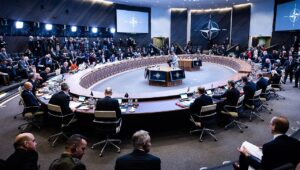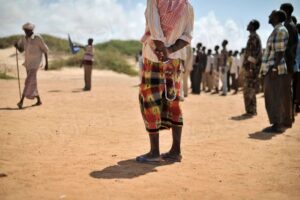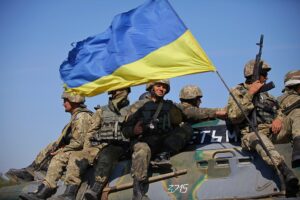Thank you, Ms. Fellin, for that kind introduction. It’s an honor to be here with you today. And my thanks to each of you for your interest in this topic and for this opportunity to discuss human security and the protection of civilians and how NATO allies can take lessons from the Ukraine conflict and apply them to future crises.
I would be remiss if I did not also thank the Dutch Ministry of Foreign Affairs for their strategic partnership and generous support of our project.
First, I want to discuss why Human Security and the Protection of Civilians are not only important but central to the Alliance’s purpose.
The security of NATO’s one billion citizens is the heart of the Alliance. Yet, the discussion about collective security, including defense and deterrence, often focuses on state-centric challenges such as military capabilities and territorial integrity. But what we have seen in Ukraine is that Human Security is equally important. That state and human security are in fact two sides of the same coin.
In peacetime, NATO Allies rely on good governance and the rule of law to keep your populations safe. But, during conflict and crisis, additional capabilities are necessary to safeguard civilians at risk of different types of violence, with needs that vary by a population’s age, gender, or other social factors. Just as NATO Allies develop advanced military capabilities to defend your territory, you must also develop advanced capabilities to protect your citizens in times of crisis or conflict. This is particularly important when an adversary employs strategies that deliberately target civilians as we see in Ukraine.
Therefore, PoC is at the center of all three of NATO’s core tasks. Looking to the Alliance’s past, present, and future operations, protecting civilians has been and will continue to be an integral part of mission success. If the Alliance cannot protect the people of their states, it will fail at its most fundamental purpose.
PoC is the common denominator of Human Security, encompassing the protection of all civilians, including those at particular risk, such as women and children. The CROSS-CUTTING TOPICS, including combatting human trafficking, protecting children in armed conflict, conflict-related sexual violence, and cultural property protection, all offer critical guidance for addressing specific protection needs.
So, the question, then, is: What can we learn from Ukraine today that we can apply in the future?
Of course, Ukraine is not an ally, and NATO nations, but not the Alliance itself, are assisting the Ukrainian government and people, so the NATO Protection of Civilians Policy does not apply in a legal sense to this conflict. However, it is a highly relevant and helpful tool for analyzing the current situation from a Human Security perspective. This is also a timely question because the lessons we learn can be incorporated as the Alliance finalizes its strategic approach for the next decade.
What has the Ukraine conflict taught us so far?
The first lesson is that the Protection of Civilians will be a central aspect of any future conflict we can reasonably foresee. The public discussion on protection of civilians, and engagement of national-level leaders in that discussion, has been greater than at any point in the 18 years that I have worked on this issue. And it isn’t just in the context of adherence to International Humanitarian Law which, of course, is the foundation of protecting civilians in armed conflict. It’s a clear, broad, public demand for a response to Russia’s tactics–including mass atrocities.
This is an essential signal for everyone in this room to hear because it indicates that if a conflict of this type and scale were to take place on NATO territory, the citizens you represent — not to mention the rest of the world —would expect their protection to be one of your top priorities. There is already pressure for NATO to do more to protect the civilians of Ukraine. In a Collective Defense scenario, that pressure would be even greater, and it will fall on you to make NATO’s most important choices. It should be intuitive, then, that protection of civilians will be essential to protecting the Alliance’s cohesion — NATO’s Center of Gravity— during a conflict.
In my experience working with NATO, both on the military and political sides, it is not yet entirely accepted that PoC is relevant to Article 5. As the Alliance ended its two-decade engagement in Afghanistan, some argued that PoC was no longer of value—that in a near-peer, large-scale, existential fight, PoC would be irrelevant or at least of less strategic relevance. The Ukraine conflict is a clear rebuttal to that view: The response of the Allies represented here, and the world has shown us that protecting civilians is a crucial concern. Now that Ukraine has sparked this shift in mindset, more can and should be done.
Thankfully, the [authors of the] 2016 PoC Policy foresaw this challenge and rightly included a discussion on protecting the population from would-be adversaries. Understanding how to anticipate and counter attacks against civilians, some of which may rise to the level of mass atrocities, is critical. This is a highly challenging task and is not a skill NATO currently has in its arsenal. Developing this capability would ensure more NATO-member civilians are protected and play an essential role in ensuring accountability and denying the adversary opportunities to use disinformation to undermine the Alliance.
The second lesson: The Ukraine conflict gives us concrete examples of how a human security perspective can help the Alliance and its members make better policy choices — both now and for the future.
In this state-on-state conflict at the doorstep of the Alliance, Civilians are dying — but not only from bullets and bombs. They are also dying from lack of access to basic needs such as food, water, shelter, healthcare, and electricity. Looking at the ongoing conflict through a Human Security and PoC lens allows NATO member states to make protection-informed decisions in support of the government and people of Ukraine.
It is not just about providing weapons; it is also about helping the government and the people trying to survive this conflict and bolstering the political will of a state to fight. The PoC Policy gives you a framework from which to do that. And for individual Allies, the policy can serve as a foundation for developing national strategies to support Ukraine.
But perhaps most importantly for the Alliance, Ukraine provides tragic but tangible insight into the PoC challenges that NATO would face in a future high intensity, state-on-state conflict on NATO soil. We must pay attention now to prepare ourselves for the future.
This leads me to my final point: How do NATO and its members take advantage of these lessons at this critical moment?
I see four key opportunities:
First is the Strategic Concept. As the focus of the Alliance shifts away from out-of-area operations to new and evolving threats from near-peer competitors, NATO must build on the tools available to safeguard the Alliance and its citizens. One way to do this is by ensuring that Human Security and the Protection of Civilians are integrated into the 2022 Strategic Concept as a critical focus for current and future strategic engagements and operations.
The second opportunity is further implementation of the Protection of Civilians Policy. Once in the Strategic Concept, you will have a platform to resource and support the further development of protection capabilities. For the citizens of NATO, future development of the capacity to implement the PoC Policy may mean the difference between life and death. One of your countries may find itself in a conflict on your soil, working with the other Allies to defend your territory and your civilians. Now is a crucial moment for you to do the work necessary to ensure you can protect your people at that moment.
Third is an opportunity to examine your nation’s Human Security and PoC policy, doctrine, and guidance. NATO’s PoC Policy can serve as a framework for your nation to develop and integrate protection into your government and security forces. Some countries already have their approaches, but understanding how they interplay with NATO will be essential in a crisis.
Finally, this is an opportunity to strengthen the political side of civilian protection. Political leaders like you need to have a solid understanding of the protection of civilians–both what it means and how you can support it. The allies around this table worked hard in 2016 to get this policy in place. But you need to go further. Political leaders must develop some muscle memory on PoC so that the Alliance can effectively resource improved capabilities and, if necessary, mandate an Article 5 mission that includes clear and achievable protection AND military objectives alongside each other.
In closing, I want to point out two resources. The Stimson Center has commissioned a paper series as part of our project. We’ve brought together a team of experts to author these papers on various topics, from Future Urban Warfare to PoC in Collective Defense to a Ukraine case study. We also have one on Resilience and PoC coming out in June. I’ll drop a link in the chat for you.
Second, my colleague Andrew Hyde, the political lead for our project, will be in Brussels next week and in the building meeting with various stakeholders. He would be happy to set up a time to meet with your delegation should you be interested to know more or developing a strategy for how to support human security and PoC, and I’ll also drop his email in the chat.
Once again, thank you for your time, and now I’m pleased to hand it over to my colleague Marco.



